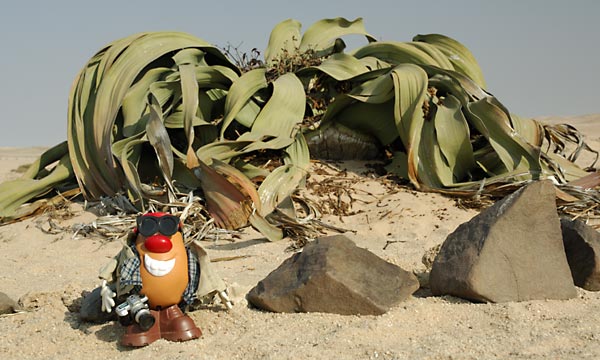
 -
Part II
-
Part II
The tater struck up a conversation with a camper next to him and found out that although they may be far from the giant dunes of the Sossusvlei (which Spud really wanted to see), they were close to Africa's Grand Canyon. Up for a side trip, the tater jumped into his rental truck and journeyed to Fish River Canyon in the southwest of the country.
Fish River Canyon is the one of the largest canyons on earth, second only in size to Arizona's Grand Canyon. The canyon began forming about 650 million years ago when a large shift in the continental plates caused a rupture in the earth. The Fish River has continued to cut deeper and deeper into the resulting crack and the result is the canyon seen today which runs about 160 kilometres (~100 miles) in length, 27 kilometres (~17 miles) wide and in places, up to 550 metres (~1805 feet) deep. The last time Spud saw a crack that big was when he had a plumber over to fix his drain pipes.
The tater decided to explore some of the many hiking trails around the area. He was entranced by the stark beauty of such a harsh desert environment.
 Along
his way, the side dish came across a rare Welwitschia mirabilis - quite
possibly the oldest living plants on the earth.
Along
his way, the side dish came across a rare Welwitschia mirabilis - quite
possibly the oldest living plants on the earth.
Only found in the Namib desert, the strange Welwitschia grows from a short, thick trunk, with only two leaves that continuously grow from their base, and a long, thick taproot. These two ribbon-like leaves eventually grow to great lengths, and coil and twist over an over in a jumbled mess. These extremely slow growing plants can live hundreds of years, with some of the very largest ones attaining up to 2000 years of age, all without nary a taste of moisture as rain is very sparse in this desert - often going years without a drop of precipitation.
Spud marvelled at how this resiliant plant can survive and thrive with no water, fertilizer or Miracle Gro. Knowing how many house plants have croaked under his care over the years, the potato had pretty much resigned himself to the fact that he did not have a green thumb - actually he doesn't have a thumb at all, but thats beside the point.
Certainly this plant wouldn't die if Spud took one home, however this rare species is highly protected in Namibia, so he wasn't able to dig one up.
Suddenly, the potato's cell phone began to ring....it was his travel agent.
 Amazingly,
he had found a vacancy near Sossusvlei. The gnome must not have scooped
up every room in the area as one had become available at the new chic
desert resort, the Sossus
Dune Lodge, an upscale African Village style complex nestled in the
heart of the area, right near the giant dunes.
Amazingly,
he had found a vacancy near Sossusvlei. The gnome must not have scooped
up every room in the area as one had become available at the new chic
desert resort, the Sossus
Dune Lodge, an upscale African Village style complex nestled in the
heart of the area, right near the giant dunes.
Nabbing the reservation, Spud jumped into his 4x4 and began heading for the mountains of sand.
Spud would learn that everything his guidebook had said was true about Namibia's enormous dunes. The tater looked on in awe at the 300+ metre (1000 foot) fiery dunes of the Sossuvlei. The star shaped waves of sand rose into the cobalt sky and their knife edges formed everchanging parabolas of shadow and light.
Spud was alone in this magical place, and the silence of the Namib desert was deafening. That is until he heard an annoyingly familiar accent yammering on, just over the crest.
Sure enough,
the tato recognized the dunce cap of his nemesis. Spud was infuriated
with this annoying little twerp; not only for the fact that Spud couldn't
find any accommodation, but mainly due to how the dwarf was fleecing the
Namibian tourism industry. The people of Namibia are working hard to develop
tourism in their country and have been a shining example to other African
nations of how to build their economy. The potato felt that no one had
the right to take advantage of these hard working people, especially the
gnome.
 The
side dish jumped the pint-sized scammer and wrestled him to the ground.
Spud then proceeded to 'plant' him in the iron-rich sand of the Sossusvlei.
Surely a final destination for this 'Roaming Gnome'
The
side dish jumped the pint-sized scammer and wrestled him to the ground.
Spud then proceeded to 'plant' him in the iron-rich sand of the Sossusvlei.
Surely a final destination for this 'Roaming Gnome'